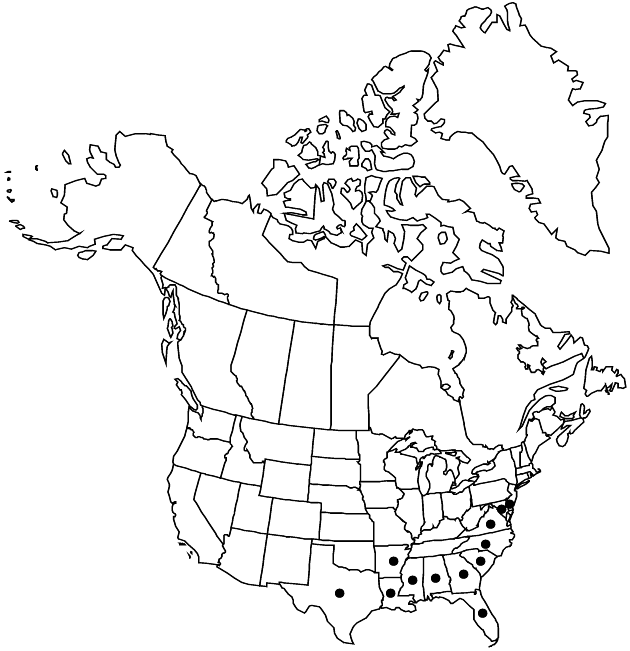Elephantopus nudatus
Proc. Amer. Acad. Arts 15: 47. 1880.
Endemic
Treatment appears in FNA Volume 19. Treatment on page 203.
Plants (1–) 3–11+ dm. Leaves mostly basal at flowering; blades mostly oblanceolate to spatulate, sometimes elliptic, 7–15 (–20+) cm × 20–35 (–45+) mm (including petioles), both faces strigose or pilose to hirsute. Bracts rounded-deltate to lance-deltate, 6–15+ × 4–9+ mm. Inner phyllaries 6–7.5 mm, sparsely strigose or hispidulous with hairs 0.05–0.3 (–0.5) mm. Cypselae 2.5–3 mm; pappi 3–4.5 mm. 2n = 22.
Phenology: Flowering Aug–Oct.
Habitat: Open or shaded, dry to wet places in pine forests and mixed forests, often on sandy soils
Elevation: 0–100 m
Distribution

Ala., Ark., Del., Fla., Ga., La., Md., Miss., N.C., S.C., Tex., Va.
Discussion
Selected References
None.
Lower Taxa
None.
"dm" is not declared as a valid unit of measurement for this property."dm" is not declared as a valid unit of measurement for this property."dm" is not declared as a valid unit of measurement for this property.
... more about "Elephantopus nudatus"
dotted +
sagittate +
introrse +
connate +
obtuse;acute +
scarious +
hirsute +
papillate +
corymbiform-paniculiform +
continuous +
cuneate +
elliptic +
mostly oblanceolate;spatulate +
ribbed;nerved;ribbed;nerved;smooth +
lance-linear;more or less lanceolate +
stigmatic +
absent +
not beaked +
2.5mm;3mm +
straight +
distinct +
proximal +
bisexual +
dispersed +
singly +
discoid +
indeterminate +
10;40 +
homogamous +
chartaceous +
surrounding +
cylindric +
alternate +
basal +
lance-linear +
toothed +
ovate +
2-carpellate +
inferior +
attached +
anatropous +
decussate +
persistent +
tough +
thick +
connate +
winged +
persistent +
distinct +
unequal +
Proc. Amer. Acad. Arts +
1880 +
absent +
epaleate +
flat;convex +
fibrous +
1-aristate +
exalbuminous +
modifed +
1;2;2;8 +
Endemic +
alternate +
2-branched +
hirsutulous +
ringed +
Elephantopus nudatus +
Elephantopus +
species +
longer +
perennial +